Heather Sansom is the author of rider fitness ebooks Complete Core Workout for Rider, and a regular columnist in several equestrian publications including Dressage Today.?EquiFITT.com offers rider fitness clinics & workshops, Centered Riding? instruction, and convenient distance eCoaching for riders anywhere.? Subscribe to receive free monthly Equestrian Fittips, and download rider fitness eBooks at:??www.equifitt.com/resources.html

If you are reaching the peak of your riding season, it may not be the time to engage in a seriously intense new strength and conditioning workout. However, you can improve your ability to move with your horse by taking a few moments each day to work on the suppleness of your own back.
We know that since your horse will reflect what you are doing with your body, tension or rigidity in your spine and back is likely to be mirrored in his. Without taking time to stretch and work out tension in your back, spending more time in the saddle may only contribute to the problem. The more time you spend in the saddle, the more you need to take time to stretch- but it doesn’t need to take a long time. Everyday and often is a better rule of thumb in a busy season, because you are creating tension and making the muscles work every day.
The Rider’s Spine
If you were looking at a rider’s spine in motion, you would see over twenty small joints gently shifting to absorb the upward movement created by your horse’s back coming up to meet your seatbones, going back down again, and also bending and turning. A rider that looks motionless is actually in constant motion. It makes more sense if you think of it in reverse: a rider who is rigid definitely has a lot of visible motion- usually jarring to the eye, their horse, and their own body.
Jarring feeds a vicious circle of physical reaction: the body tenses even more to try and stabilize you, and this increases the jarring because it further diminishes your ability to flow with the motion created by your horse. If you don’t end up feel less balanced as a result, your horse will certainly notice the pressure on his back.
I have worked with many amateur riders, as well as some of our elite dressage riders and trainers. Interestingly, tension in the spine can be a problem at both ends of the spectrum and everywhere in between.
Keeping a healthy, moveable spine is actually important for everyone in daily life and in other sports. Problems with mobility in your spine not only reduce motion in your hips, but contribute to muscle tension in your back and shoulders, and even affect other organs and parts of your body and movement. Nerves coming out of your spinal chord to the rest of your body can be impinged. Long term, lack of mobility can lead to disk degeneration and permanent damage. So, taking your riding needs as a good excuse to keep on top of suppleness in your back will actually help you generally.
Stretching the Whole Spine
Depending on your body type and how you use your body riding, you may experience more stiffness in your lower or upper back. I like to suggest you do some stretches for both to cover all your bases. My rule of thumb is very simple: take your spine in all four directions and also in rotation.

Use gentle flowing motions when you stretch before riding, and stay in your stretches as long as you can later in the day for maximum gains. Most people do not stretch long enough, and so they never get past the first layer of muscles. When it comes to your spine, you have many muscles in your back and right up your spine. The smallest muscles will never even see the benefits of your stretch, unless you do it long enough, or repeat it enough.
Here are some effective stretches that can help you improve your riding:

Stretch #1: Rounding and Hollowing on All Fours
A really simple stretch, that is easy to do on the road, is simply rounding and hollowing your back on all fours. This stretch is also known as ‘cat and dog’ poses in yoga. It’s important to repeat several times, integrating deep breathing to help your body relax.
During this stretch, you must pay close attention to holding the stretch long enough to affect the multifidi muscles. They connect between your vertebrae and ribs in the spine and are some of the last muscles to relax, because they are usually constantly busy holding you upright.

Also, watch for your body’s tendency to want to cheat by absorbing more of the motion in one area than another. Make every effort to hollow and round your back evenly along its length.
Stretch #2: Extending Your Spine
A more advanced pair of stretches to flex and extend your spine are designed to be held for a longer period of time. A minimum of 30 seconds is recommended, but if you can hold the stretch for a minute or two that is even better.
To extend your spine, lay back over a fitness ball (or haybale, cooler etc.) to extend your spine. If you feel pain in your lower back, you are hyper-extending your lower back and your spine is not rolling evenly into the position.
You can modify the stretch by picking your pelvis up a little to reduce bend in your lower back, while allowing your upper back to continue to mold over the fitness ball until your upper back “lets go”. I have found that it is quite common in a dressage rider to have a very inflexible upper back, which makes taking the time to stretch it even more important.
Stretch #3: Flexing Your Spine
The reverse position is also known as plow pose in yoga. To get into the position, lie on your back with your knees bent. Lift your seat off the floor and place your hands at your waist with elbows on the floor. Lift your feet up and bring your knees over your head- you are now doing a curled up sort of shoulder stand on three points: elbows and base of neck/head. You can extend your legs over your head and slowly lower your feet toward the ground. As you start out, it feels kind of like a shoulder stand. Only let your legs lower toward the ground as far as you can comfortably. It is quite common for someone starting out with this stretch to feel some disks in your back fold more than others, or to feel a hamstring stretch in the back of your legs. Do not let your back take more motion at any one point- if you feel pain in a precise zone, ease out or cease the stretch.
This position feels almost suffocating to the lungs at first because they are getting compressed. You can “ease out” of it by bending your knees and lifting your legs up. If you are sick and your lungs are congested, or you have an asthma or other already constricting lunge condition, be very careful not to overdo this pose. A safer alternative might be simple bending forward in a seated position, and attempting to round your back as much as possible.

You can also modify it by doing it up against an object like a couch, where you can rest your legs comfortably. The goal, especially for a dressage rider, is to cause your upper back to flex and round. The more advanced a rider you are, the more you are likely in need of stretches like these because of the way you maintain a very straight posture for so many hours, against repeated ‘load’ from the horse.
If you feel any dizziness or nausea after back stretches, you should cease them and consult your doctor, physiotherapist or chiropractor.
CALL FOR TOPICS: Over the past several months of Rider Fitness articles, we have covered many topics related to rider fitness. We would be interested in knowing more about the topics and issues you’d like to hear about. Please write to [email protected] to suggest topics you’d like to see covered in future pieces.










